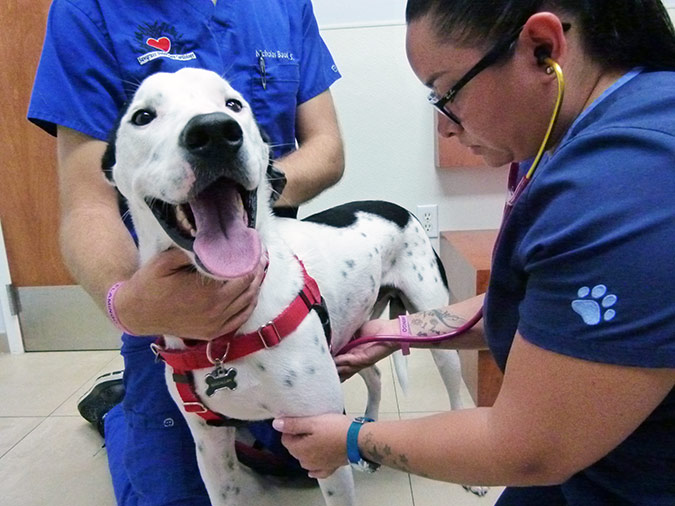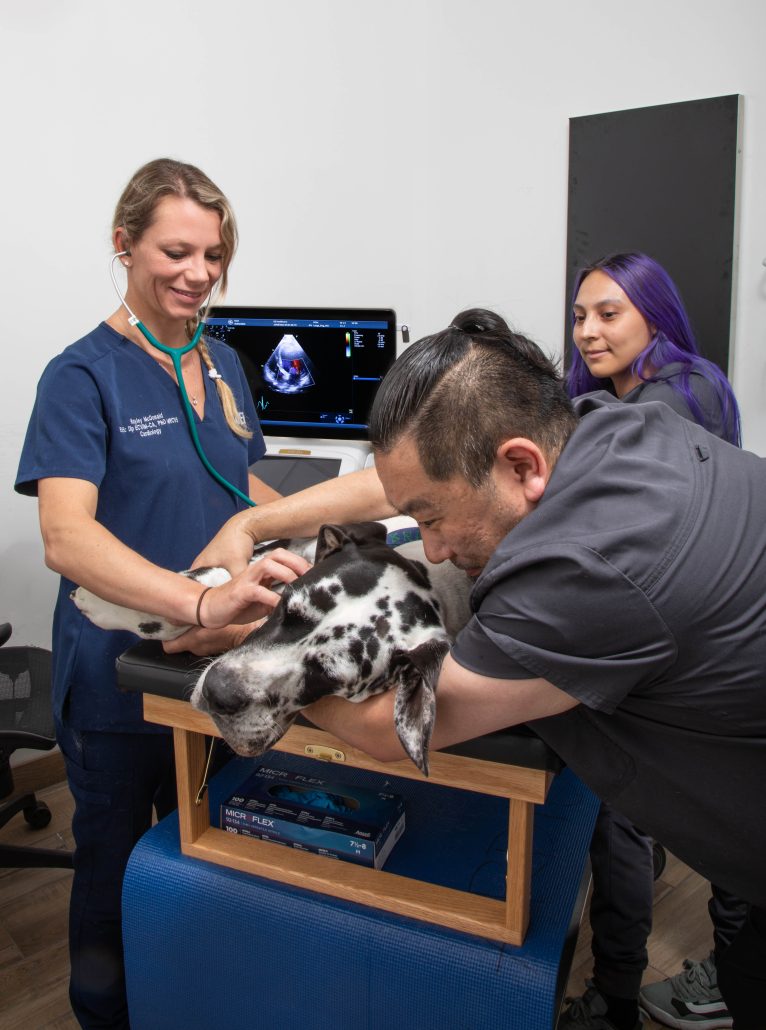What You Need to Know About Vet Services: An Overview of Diagnostic Devices and Procedures
Veterinary solutions play a vital role in maintaining the health of pets. Routine check-ups can expose surprise health issues early on. Different diagnostic tools and treatments, such as blood tests and imaging strategies, supply necessary insights right into an animal's health. Comprehending these methods is essential for pet dog proprietors. What specific diagnostic treatments are most typically made use of, and just how can they influence an animal's therapy strategy?
Relevance of Normal Veterinary Exams
While numerous pet proprietors might ignore the value of routine veterinary exams, these consultations are vital for preserving a pet's total health. Routine brows through to the veterinarian allow for early detection of possible health issues before they intensify right into serious issues. Routine examinations usually include vaccinations, which are crucial for stopping contagious illness that might drastically impact a pet's well-being. Furthermore, these visits supply a chance for vets to analyze the pet's weight, oral health and wellness, and overall condition, making sure that the pet dog is growing. During these gos to, family pet owners can also receive valuable guidance on diet, exercise, and preventative treatment customized to their certain animal's needs.
Common Diagnostic Procedures in Vet Medicine
In veterinary medication, exact medical diagnosis is essential for effective therapy. Usual diagnostic procedures consist of blood screening strategies, progressed imaging innovations, and urinalysis, each playing a considerable role in identifying health issues. Recognizing these techniques enhances the ability to give ideal care for animal people.
Blood Examining Methods
Blood testing methods serve as necessary diagnostic devices in veterinary medication, enabling veterinarians to examine the health of pets precisely. These techniques entail collecting blood examples to analyze various parts, such as white and red blood cells, platelets, and biochemical pens. Usual tests consist of total blood matters (CBC), which evaluate general health and detect infections, and biochemical panels, which examine body organ feature and metabolic condition. In addition, serological tests can recognize specific conditions through antibody detection. Blood screening is minimally intrusive and provides critical details that assists in identifying problems, keeping track of health and wellness standing, and evaluating actions to therapies. In general, these methods play an important role in ensuring suitable take care of animals and animals alike.
Imaging Technologies Utilized
Diagnostic imaging technologies are crucial devices in veterinary medication, enhancing blood screening methods by providing visual insights into an animal's interior frameworks. Typical imaging methods consist of X-rays, which work for evaluating bone fractures and finding international objects, and ultrasound, which permits real-time visualization of soft cells and organs. Magnetic resonance imaging (MRI) offers thorough photos of intricate physiological locations, particularly in neurological analyses. Calculated tomography (CT) gives cross-sectional photos, boosting analysis precision for numerous problems. Each of these modern technologies aids vets in detecting ailments, intending therapies, and monitoring recuperation. By including imaging innovations, veterinary professionals can better assess a pet's health and wellness and make educated decisions regarding their care.
Urinalysis and Diagnostics
Urinalysis works as a critical analysis device in veterinary medicine, providing beneficial understandings into a pet's total health and wellness and helping in the detection of different conditions. This non-invasive procedure assesses pee samples to assess kidney feature, hydration condition, and metabolic disorders. Usual components examined consist of particular gravity, pH degrees, glucose, proteins, and the visibility of blood or bacteria. Uncommon findings can suggest issues such as urinary system tract infections, diabetic issues mellitus, or kidney condition. To boost diagnostic precision, urinalysis is commonly carried out in conjunction with other tests, such as blood job and imaging research studies. Early detection through urinalysis can result in timely interventions, improving the prognosis for several veterinary people. Consequently, it is a necessary element of extensive vet care.
Recognizing Blood Tests and Lab Evaluation
Understanding blood tests and research laboratory analysis is essential in veterinary medicine as it helps in identifying numerous wellness problems in animals. Different types of blood examinations provide crucial info regarding a pet's internal state, while translating laboratory results requires careful factor to consider of numerous elements. This section will certainly discover the kinds of blood examinations available and the relevance of their outcomes.
Kinds Of Blood Examinations
Blood examinations play an important function in vet medication, supplying essential understandings right into an animal's health and wellness condition. Different sorts of blood examinations are used, each offering various functions. Total blood counts (CBC) examine general health and discover conditions such as anemia or infection. Biochemical profiles assess organ function by gauging enzymes and electrolytes, using insights into metabolic wellness. Serological tests identify certain antibodies or virus, helping in the diagnosis of infections or autoimmune conditions. Blood inputting guarantees secure transfusions, while coagulation tests evaluate the blood's capacity to clot, vital for surgeries. These tests jointly boost diagnosis, therapy planning, and surveillance of an animal's health, illustrating the relevance of comprehensive lab evaluation in veterinary treatment.

Analyzing Laboratory Results
A comprehensive analysis of laboratory outcomes is necessary for exact medical diagnosis and therapy in veterinary medication. Interpreting lab results requires an understanding of typical referral varieties and the significance of variances. Blood tests can reveal different health and wellness signs, such as body organ feature, electrolyte balance, and the existence of infections. Vets have to think about the whole medical photo, consisting of the animal's history, checkup findings, and any signs and symptoms provided. Variations in outcomes may develop from aspects such as age, breed, and underlying health conditions. Lab results should not be seen in seclusion yet instead as component of an all-inclusive diagnostic approach. Precise interpretation permits for customized treatment strategies and better results for vet clients.
Imaging Techniques: X-rays, Ultrasounds, and Beyond
Imaging strategies are essential devices in vet medication, offering vital understandings into the wellness and wellness of pets. Among the most commonly made use of approaches are Ultrasounds and x-rays. X-rays are very useful for imagining bone structures, helping veterinarians identify cracks, lumps, or foreign things. This technique is non-invasive and quick, making it suitable for urgent situations.Ultrasounds, on the various other hand, utilize sound waves to produce images of soft cells and organs. This strategy is especially useful for checking out the heart, abdomen, and reproductive body organs, allowing veterinarians to assess problems like liquid accumulation or body organ abnormalities.Beyond X-rays and ultrasounds, advanced imaging strategies such as computed tomography (CT) and magnetic vibration imaging (MRI) are increasingly used in vet method. These approaches provide thorough cross-sectional click to investigate pictures, enhancing the accuracy of medical diagnoses and therapy plans. Cancer Veterinary Near Me. On the whole, imaging techniques play a crucial role in making sure effective veterinary treatment
The Duty of Biopsies in Diagnosing Pet Health And Wellness Issues
Accuracy in diagnosing health concerns in pets often rests on using biopsies, which offer clear-cut details regarding cells abnormalities. A biopsy involves the removal of a little example of cells for exam under a microscope, permitting veterinarians to recognize different problems, including infections, lumps, and inflammatory conditions. This diagnostic tool is essential for identifying in between malignant and benign growths, directing therapy choices, and reviewing the seriousness of a condition.Biopsies can be performed utilizing different techniques, such as needle goal, incisional biopsies, or excisional biopsies, depending on the place and sort of tissue involved. The choice of technique might influence healing time and the quantity of tissue gathered. Inevitably, the info gleaned from a biopsy can result in targeted treatments, enhancing results for family pets dealing with significant health and wellness obstacles. Vets highlight the relevance of this procedure in achieving exact diagnoses and effective treatment strategies.
Advanced Diagnostic Equipment: Endoscopy and CT Scans

Advanced analysis tools, such as endoscopy and CT scans, play an important duty in modern veterinary medication, providing non-invasive approaches to imagine inner structures and identify various conditions in pet dogs. Endoscopy involves using an adaptable tube geared up with an electronic camera, enabling vets to take a look at the gastrointestinal system and breathing system directly. This method can reveal problems such as growths, international bodies, or inflammation, allowing targeted therapy plans.CT scans, on the other hand, use innovative imaging technology to produce detailed cross-sectional Read Full Article pictures of the body (Ultrasound For Dogs). This method is especially valuable for assessing complicated frameworks like the mind, back, and joints. By supplying high-resolution photos, CT scans assist veterinarians in determining issues that may not be obvious via conventional radiography. With each other, these sophisticated devices boost analysis precision, boost therapy results, and ultimately add to better general pet dog wellness monitoring

Interpreting Examination Results: What Family Pet Owners Ought To Know
Understanding examination outcomes can be a difficult job for animal owners, especially after innovative procedures like endoscopy and CT scans have been executed. Translating these outcomes requires a grasp of medical terms and a clear understanding of what the searchings for indicate concerning the pet's health and wellness. Veterinarians usually offer descriptions, but the complexity of the results can still bring about confusion.Pet owners ought to proactively take part in discussions with their veterinarians, asking inquiries to make clear any uncertainties. It is necessary to recognize regular versus abnormal results and the ramifications for the animal's therapy strategy. Additionally, acknowledging that some outcomes might call for additional screening or surveillance can aid owners stay notified concerning their pet's health journey. Ultimately, a collective technique in between pet dog proprietors and vet specialists promotes far better health results and boosts the general treatment experience for pet dogs.
Often Asked Questions
Exactly how Do I Select the Right Vet Clinic for My Family pet?
Selecting the ideal vet center includes investigating neighborhood choices, assessing certifications, seeing facilities, and assessing staff communications (Board Certified Veterinary Cardiologist). Focusing on suggestions from relied on sources can help ensure the ideal care and atmosphere for a pet dog's health requirements
What Should I Do if My Pet Declines to head to the Veterinarian?
When a pet rejects to go to the veterinarian, it's advisable to remain calm, use treats or playthings to entice them, and take into consideration setting up a home browse through if anxiousness persists. Patience and favorable reinforcement are essential.
Exist Telehealth Options for Veterinary Solutions?
Telehealth options for vet solutions are increasingly available, enabling pet dog owners to seek advice from vets from another location. These services allow conversations concerning wellness concerns, guidance on minor ailments, and follow-ups without requiring to visit a clinic.
Just how Commonly Should My Family Pet Have Oral Examinations?
The frequency of dental check-ups for pets usually depends on their age and breed. visit the website Usually, vets recommend yearly dental examinations, although some pet dogs may need more constant check outs to maintain suitable oral health.
What Are the Costs Connected With Vet Diagnostics?
The costs connected with veterinary diagnostics can vary widely, usually varying from standard tests like blood job to innovative imaging strategies. Factors influencing expenses consist of the facility's area, devices made use of, and details tests required for each and every family pet. Vet services play an essential function in keeping the health of pet dogs. While lots of animal proprietors might ignore the relevance of routine vet check-ups, these visits are crucial for maintaining an animal's total health and wellness. In addition, these visits provide an opportunity for vets to evaluate the pet's weight, oral wellness, and general condition, guaranteeing that the pet dog is growing. Precision in detecting health concerns in animals typically hinges on the use of biopsies, which offer definitive info concerning tissue abnormalities. In addition, identifying that some outcomes may call for further screening or tracking can help owners stay educated regarding their family pet's wellness trip.